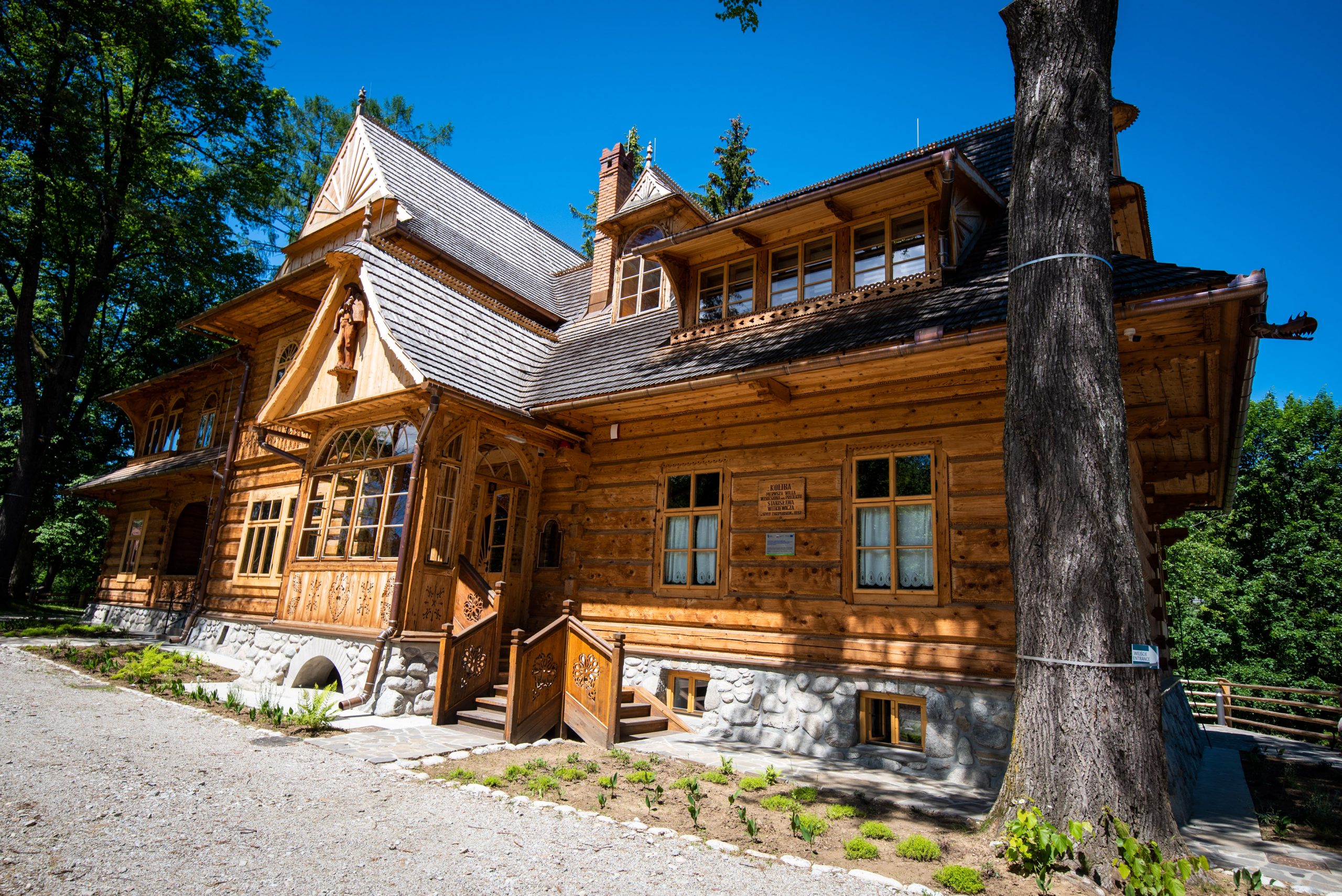Prices:
normal ticket 17,00 zPLN
reduced ticket 10,00 PLN
guided tour: 40,00 PLN
large family card : 5,00 PLN
max. 2 adults + max. 4 minors: 35 PLN
groups > 15 p. + 1 adult for free: 8,00 PLN
audio guide: 5,00 PLN
One ticket for Villa Koliba and The Museum of Zakopane Style at Roje street
normal 22.00 PLN, reduced 12.00 PLN
free entry every Sunday
Opening hours:
TUE- SUN 10.00 AM – 6.00 PM
MON - closed
Address:
34-500 Zakopane
+48 18 26 37 065
koliba @ muzeumtatrzanskie.pl

(branch of the Tatra Museum)
The Koliba villa, the first building erected to Stanisław Witkiewicz’s design in the Zakopane Style, is situated at Kościeliska Street, Zakopane’s oldest street with time-honoured houses and characteristic Tatra crofts at every step. In these surroundings we can better understand Stanisław Witkiewicz’s concept.
With the appearance of Swiss- or Tyrolese-styled architecture in Zakopane, alongside many other Polish health resorts, in the second half of the 19th century, Witkiewicz realized that in order to protect Podhale from buildings stylistically alien to the region, a style growing from the local building art should be wrought. Witkiewicz started a press campaign to promote the style. In his reports and articles, he appealed for the use of local motifs in the houses erected by the newcomers and visitors.
At this time, Zygmunt Gnatowski the owner of Jakimówka estate in Ukraine and collector enamoured of the culture of the Tatra Mountains felt an overwhelming desire to have a summerhouse built for him in Zakopane. At first, he was thinking of a cottage like those used by the Tatra people. However, Witkiewicz persuaded Gnatowski into having a house in the Zakopane Style erected instead. The Koliba (which name derives from koleba, a kind of shepherd’s shed) was built in 1892–93 by the local carpenters. The interiors were likewise stylishly arranged with furniture and household utensils as well as specially designed tile stoves, cornices, curtains, and even small cast elements such as door handles and outer elements of the locks.
Originally the Koliba villa looked different from what it does today. In 1901, Gnatowski had a huge wing added on the west, which transformed Witkiewicz’s original design by altering the mass of the building. In 1906 Zygmunt Gnatowski died in his native Jakimówka. He left no heirs, and the Koliba was sold. The ethnographic collection that Gnatowski had kept in an interior called the Tatra highlander’s chamber has found itself in the Tatra Museum in accordance with his will.
From then on, the Koliba changed owners several times. Unaware of its value, they were not concerned about its condition. In 1935, the Polish Rail Military Training Division purchased the building, intending to organize a pension here. In the course of repairs and adaptation, most of the original stoves were dismantled and the unique stylish floors changed. The same happened to the original decoration of the façade. New motifs, characteristic of Art Déco, were introduced inside.
Serving as the seat of the German youth organization Hitler-jugend during the Nazi occupation, the Koliba survived the period without damage. After the war, at first a rest house, it was an orphanage till December 1981. In 1984, the Tatra Museum ordered and supervised repairs to stop the degradation of the deserted building; in 1987 conservation-cum-repairs were launched, later the interiors were arranged. Almost a century after the erection of the Koliba, the Museum of the Zakopane Style was opened here in December 1993. The interiors were arranged by Władysław Hasior.
Five rooms in the oldest part were arranged in accordance with their original function as, on the ground floor, the dining room, drawing room and bedroom, and, on the first floor, Gnatowski’s room and his servant’s room.
Zygmunt Gnatowski’s ethnographic collection returned to its place in the ‘Tatra highlander’s chamber’. Other pieces of furniture, household utensils and small craftsmen’s articles, all in the Zakopane Style, come from the turn of the century when the style was in full bloom. They were manufactured to designs prepared by Stanisław Witkiewicz, his pupil and closest co-worker Wojciech Brzega, and Stanisław Barabasz. Barabasz, from 1901 head of the School of Timber Industry in Zakopane, was credited with the introduction of the Zakopane Style into school workshops. To offer material for comparison, the servant’s room has been provided with furniture designed by František Neużil, the first head of the school. Neużil himself introduced the term ‘Zakopane style’ to describe his self-designed furniture decorated with the typical Podhale ornaments. Witkiewicz was highly critical of this aspect of Neużil’s activity, charging him primarily with a failure to understand the essence of the Tatra people’s style and superficiality and artistic incompetence in the use and interpretation of folk art ornaments.
The Museum of the Zakopane Style is the only place in Poland acquainting the visitor with the history of the achievements of the first theoretically wrought and successfully effected concept of a Polish national style based on the architecture and decorative art of the inhabitants of the region of Podhale.
The Koliba villa opens the brief history of the Zakopane Style, which lasted barely twenty years. After the Koliba, Witkiewicz designed several other buildings in Zakopane, of the villa-cum-pension type, in that the most beautiful, called Pod Jedlami [House Under the Firs]. He also designed furniture, various objects of daily use and elements of the furnishing of the Holy Family parish church. He designed the Sacred Heart Chapel at Jaszczurówka. The main building of the Tatra Museum was erected in brick and stone to the artist’s last design drawn in 1913.


